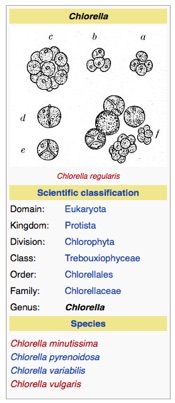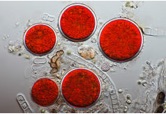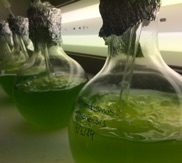1. Microalgae and its metabolites
1.1 What are microalgae?
Microalgae are a class of photoautotropic microorganisms of which there are several groups. Cyanobacteria are another type of photoautotrophs that can be treated as microalgae from an engineering standpoint. However, they are biologically very different from microalgae.
Autotrophs: Use CO2 as a carbon source.
Phototrophs: Use light as an energy source.

Microalgae are also unicellular, microscopic organisms.
In this sense, microalgae are unique: fast-growing unicellular organisms that thrive using sunlight as their sole energy source and use only CO2 to build the carbon backbone of its biomolecules.
Microalgal strains.
There are many types of microalgae. Each specific type we will refer to is called a strain. A strain is a particular case of a microalgae belonging to a given genus and species. For instance, Chlorella pyrenoidosa or and Chlorella vulgaris are species of the genus Chlorella. Note that the genus name is written in capitals while the species name is not.
As you can see in the image shown next, species are classified in a division, class, order and family. For instance, Cholorella genus belongs to the Chlorophyta divission alson known as “green algae”. This classification can be useful to get information about any microalgae species.
Within a given species, there may also be variability just as there is among Homo sapiens. Thus, a proper identification of the organism you are dealing with should accompany the registry number of a known collection. For instance, Phaeodactylum tricornutum UTEX 640 is a well known strain of a species of Phaeodactylum stored at the University of Texas collection with registry number 640.
You may find more information in a “strain browser” such as the one you can find here.

Biochemical profile.
Microalgae strains differ widely in a variety of aspects such as growth rate, nutrient needs, or optimal temperature. More importantly, the biomass obtained from different microalgal strains can have very different composition in substances such as protein, pigment or fatty acid type and amount .
For instance, Haematococcus pluvialis synthesizes and accumulates the highly-valued carotenoid asthaxantin. See the obvious differences in pigment content shown in the images on the right and below.


It is very important to choose a microalgae with an adequate biochemical profile for a given application. For instance, in aquaculture, after hatching, juvenile fish need a supply of microalgae containing long-chain polyunsaturated fatty acids (PUFAs) such as EPA or DHA. If you intended to produce betacarotene, it would be a good idea to choose Dunaliela salina.
A word of warning: the accumulation of some substances is some times triggered by a stress factor. This must be taken into account when designing culture systems for a given purpose.
Culture needs.
The conditions microalgae strains need to grow optimally differ dramatically. Factors such as pH, temperature, light intensity (amongst others) and the kind and concentration of nutrients they require must be kept sometimes under close control to obtain a productive culture.

The information supplied in culture collections can be very useful. Most of the time it is possible to find the recipe for an adequate medium to grow a given strain. If you do not find your particular strain, knowing some of its “relatives” (strains related by genus or family) may give you some helpful information.
We will discuss in detail the needs of mass cultures later on. Mass cultures require not only the proper nutrients, but also a correct calculation of their concentration and supply rate.

Questions and exercises.
-
•Find the classification for Haematoccocus pluvialis and Phaeodactylum tricornutum.
-
•Find adequate culture medium recipes for the strains mentioned above.
-
•Find a microalgae that contains EPA (eicosapentaenoic acid).
-
•What is the main distinguishing feature of the genus Anabaena sp.? What does sp. stand for? (hint, this is NOT a microalgae).
-
•Name some species of Anabaena. Find its nutrient needs.
-
•Find what triggers the accumulation of asthaxantin in Haemtococcus pluvialis. Find out what is the main factor triggering lipid accumulation in microalgae.





